How to create a brand. Is that a loaded question or what?
When I say “branding,” I am almost 100% certain that your mind went instantly to a logo.
Am I right? I bet I’m right.
And there’s no shame in that. Because you’re one of the tens of thousands out there that believe branding is a logo and a logo only. So, they believe that, when they search for “how to create a brand,” they’ll be met with logo making tutorials.
And while a logo is a key player in your brand identity, there’s so much more to it.
The world of branding is a colourful, creative, and immersive setting. And, if you get it right, you’ll create a stand-out business that speaks to the right kind of people. (That, by the way, is a huge element in making your bank account go “boom!”)
So, in today’s post, I’m going to teach you how to create a brand. We’re going to be looking at how your brand can be memorable, unique, and booming in 2023 and beyond.
What Exactly Is Branding?
First, we need to clear up some misconceptions in terms of how to create a brand. If you thought branding extended to a logo only, it’s time to brush up on the real definition of branding.
Shopify defines branding as “ the process of creating a distinct identity for a business in the mind of your target audience and consumers.”
In plain English?
Branding is all the components that give people a perception of who your business is. It makes your business human.
Components like your colour palette, typography (i.e. fonts), and – yes – your logo all work together to create a personality. That, among many other things which we’ll cover in this post, turns a business into a brand.
Branding is the process of making that happen.
What Is a Brand Identity?
Now that we’ve covered the definition of branding, let’s dig into the intricacies.
When considering how to create a brand, brand identity is critical. A key pillar in branding, brand identity refers to the way your brand is identified with.
Elements like your design, logo, colours, fonts, and illustrations work together to structure a strong brand identity. Combine that with what your brand says and how they say it, and you’ve got a brand identity.
Brand identity focuses on both the value your business brings people and its personality.
Think about your favourite movie. Chances are, you identify and resonate with one (or more) of the characters.
We cheer on the characters we feel we can relate to. In short, we want those we like to “win.”
This doesn’t change in the world of branding. In fact, it’s amplified.
Because, when you run a business, your “fans” have to part with their money in order to help you win. The stakes are higher. So your brand – your character – needs high levels of relatability and likability. The key? A strong brand identity.
Without personality and humanisation, your business is just that. A business.
When you incorporate and work on branding, though? It becomes a brand.
What Is Included In Brand Identity?
Brand identity consists of 8 core elements. These 8 elements will shape the way people perceive your brand, so – as a brand owner – it’s your job to give off the right impression for the right people. Leaving it to chance will end in a diluted, not-so-memorable perception of your business.
So, with that in mind, here are the core 8 components that make up your brand identity.
1. Your Brand’s Purpose
We’re heading back to basics here, but you’d be amazed at how many business owners didn’t expect “brand purpose” to come up when learning how to create a brand. These same entrepreneurs skipped this step because they thought it was “obvious.”
Skipping this will end badly. You, more than anyone, need to know your brand’s purpose and position in simple terms. If you can’t explain what you do, the value you provide, and the problem you solve, you need to go back to the drawing board and stay there until you can provide the answers.
Your brand’s purpose is known as your “why.” You may have heard it referred to as your North Star, too.
Essentially, your brand’s purpose answers the question: Why is your brand here? It’s the deeper, bigger reason for your business’s existence.
It’s important to note, too, that a generalised, sweeping statement isn’t enough. Your purpose needs to be super specific to the brand.
Examples of Brand Purpose (Real Brands): Crayola
Let’s look at a brand purpose example.
Crayola – the stationary brand, most famously known for their coloured crayon products – has a brand purpose of “to unleash the originality in every child.”
A generalised sweeping purpose statement, however, could’ve been “to allow young children to draw.”
It’s not nearly as profound as their actual purpose.
Plus, Crayola’s focus on “originality” adds more depth. It suggests that every child who uses the product will create something truly original, which speaks volumes about their brand’s ethos. It also references the user right there and then (”child.”) Their use of the word “unleash” suggests that every child has a natural instinct to be original. Their purpose is allowing them to do so.
Examples of Brand Purpose (Real Brands): Starbucks
Another great example of brand purpose is Starbucks, who state “to inspire and nurture the human spirit – one person, one cup, and one neighbourhood at a time.”
Avoiding generalised purpose statements like “to give people a caffeine hit,” Starbucks, instead, draws the focus onto values like inspiration and care. And they round it off by referencing their product (”one cup”) as well as a sense of community (”neighbourhood.”)
Both of these brands are stellar in teaching you how to create a brand.
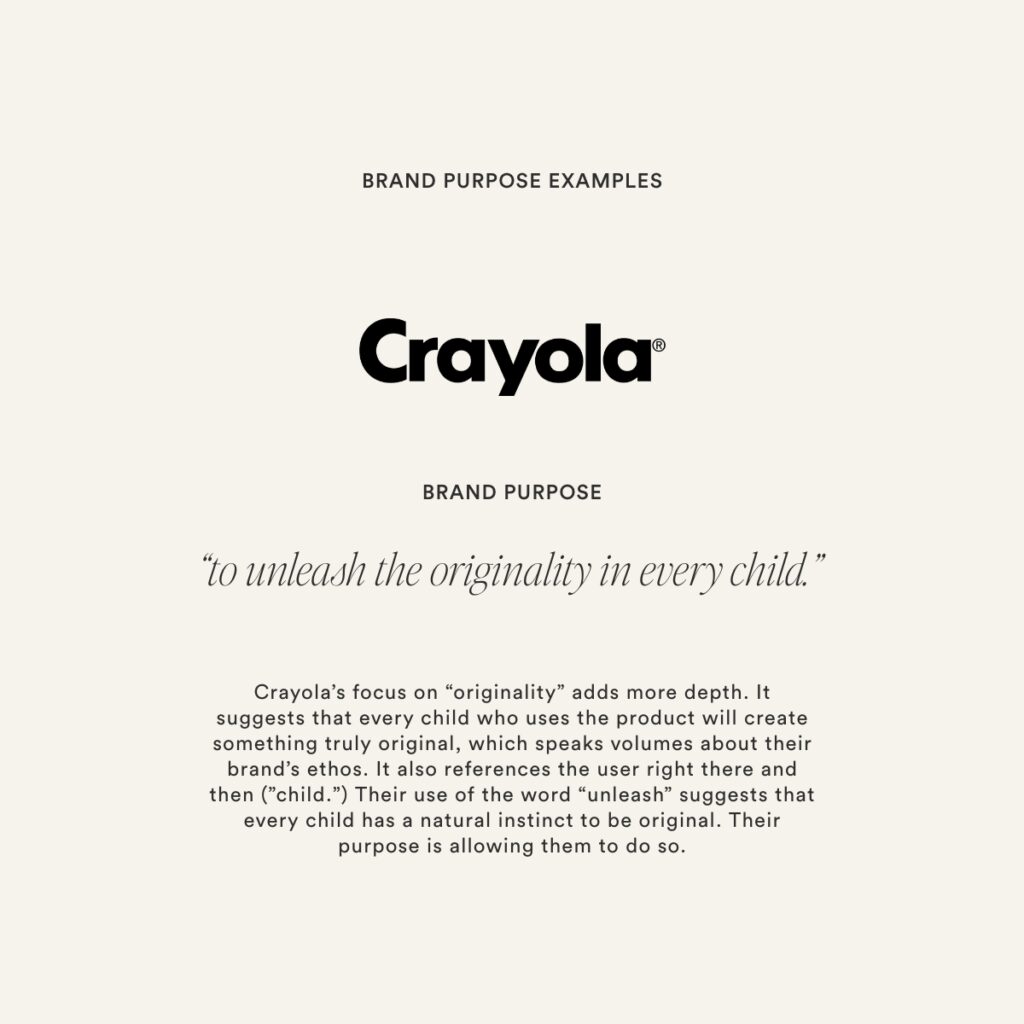

How to Identify Your Brand’s Purpose
It’s important to dig deep to find your brand’s purpose. Begin with a sweeping statement and dig deeper. You’ll end up with a list of sentences, each more specific than the last.
If you’re struggling, use these brand purpose prompts to help you:
- Who exactly was your brand made for?
- How will the person feel when interacting with you?
- In what way do you want to change and shape the world we live in?
- What could happen if your brand didn’t exist?
- If making money was off the table, why would your brand do what it does?
Looking At The Answers (How to Create a Brand)
Imagine, for a moment, that you owned a wedding bakery and you’re exploring how to create a brand. Your business supplies bride-and-grooms-to-be with their wedding pudding. But you don’t offer cake.
Using these prompts, your answers could be something like:
- My brand was made for non-traditional, engaged couples in London who want a statement dessert but aren’t fans of cake.
- My customers will feel encouraged to be original, accepted for who they are, and enthusiastic about doing something different.
- I’d like to change the world by reshaping the way bride and grooms-to-be incorporate dessert foods on their big day. There’s a lot of couples out there who don’t actually like cake, and spend an eye-watering amount on a wedding cake just for tradition. They’ll get a cake to please their older relatives who feel a cake is a must-have at a wedding. I’m trying to reduce wedding politics by offering alternatives that will get eaten, have the same show-stopping impact, and aren’t a huge waste of money.
- If my brand didn’t exist, couples would feel forced to spend hundreds (if not thousands) on a cake that they didn’t even want. They’d be bitter about the money they’ve spent. They would also feel like they purchased a cake to please everyone else in the name of tradition, and feel that their big day wasn’t exactly what they wanted.
- My brand – if making money was off the table – exists because there are thousands of couples out there who are searching for cake-alternatives. They don’t want to give up the impact of a cake, but they won’t actively eat it. I do what I do because I want every bride and groom to have a wedding that best represents them. And that includes the sweetest part of their day (other than their vows!).
Obviously, you’ll then need to focus on your key points and snip it down to one sentence (two max.)
However, these prompts are great to help you dig deep when finding your brand’s purpose.
2. Your Brand’s Positioning
When understanding how to create a brand, you’ll know that positioning is just as important as purpose.
In short, your brand’s positioning answers who your brand is for and why your business is better than the competition.
It allows you to take your brand’s purpose and make it actionable. Having a fantastic brand purpose is one thing. But until you have your brand positioning, your purpose is simply a dream that cannot be acted on.
Different Types of Brand Positioning
The reality is this: your brand will be perceived by people. That is out of your control.
What is in your control, though, is how people perceive your brand. That’s why brand positioning is such an important lesson in how to create a brand.
It allows you to stand apart from your competition and prove why you’re different (and better) than others in the market.
You can leverage many components as a key brand positioning differentiator. Some included are:
- Price
- Quality and value
- Convenience
- Customer service
- Uniqueness and differentiation
- Out-right competitor comparison
The Brand Essence Chart For Brand Positioning
If you’re struggling to define your brand’s positioning, have a go at creating a Brand Essence Chart.
Created in 1995 by an advertising firm Bates Worldwide Agency, the Brand Essence Wheel is somewhat different from the Brand Essence Chart. The wheel focuses on how to create a brand as a whole, while the chart – posted by HubSpot – has a direct focus on brand positioning.
The chart asks you to consider the following 7 elements:
- Attributes
What are the features of your product or service? - Benefits
How does your product or service change someone’s life? - Personality
What 6-8 personality traits do you want your brand to portray? - Authority and Support
What allows your brand to be credible in what you do? EG: Experience, awards, reviews, case studies, etc. - What These Say About The Customer
After answering the above, what does it say about a paying customer? EG: Motivated by social proof, responds well to humour, searching for something innovative. - How It Makes The Customer Feel
When someone interacts with your brand, how do you want them to feel? Inspired, for example, is highly different to entertained. - Your Brand Positioning
When you combine these answers, you’ll be able to highlight the key components and create a simple sentence that outlines what people will take away from your brand.
The Brand Positioning Framework
If you’re more into frameworks or you’re looking for a little more extra guidance in terms of structure, it may be more worthwhile to explore how to create a brand with the Brand Positioning Framework.
Wynter explains that their Brand Positioning Framework “gives a top-down view of your strategy, and you may choose to finish with some of the key touchpoints to be used by marketing in your brand messaging.”
This Brand Positioning Framework consists of 4 key pillars:
- Define
As of right now, how do customers (and ex-customers) perceive your brand? - Target
Who are you targeting? What do they need? What are they struggling with? How are they feeling? - Evaluate
How do you want your customers to see and feel about your brand? What value does your brand give them? - Research
Finally, take a deep-dive into what your competitors are doing right (and wrong). Compare this with the notes you took in the “Target” and “Evaluate” phase. Are they giving your people what they want?

3. Market Research (& Lots Of It)
Next up on the list of crucial elements for a top-notch, memorable brand in 2023 is market research.
While you might flinch at the thought of it, it’s critical for your brand’s success and dominance in your industry.
Realistically, you’ll find that, once you’ve done your market research correctly, you may want to edit or add to your brand positioning and brand purpose. That’s completely normal. And, if anything, it proves you’re responding to data and current events.
Market research is the process of learning about how to create a brand for your specific market and industry. Whether that’s understanding the demand for the value you provide, patterns in objections, or competing prices, it all revolves around market research.
How To Do Market Research
You may be aware that you should be doing market research. But it’s easier said than done when you don’t know how to do it in the first place.
Market Research Method 1: Talk To People
One of the most effective methods of market research? Getting out there and actively talking to people. I’m not saying head out into the streets and strike up conversations with anyone who walks past (though this could work in some circumstances!). Phone interviews – with prior consent, of course – are highly effective.
Market Research Method 2: Surveys
If that’s not an option for you, consider leveraging surveys for your market research. Take a look at Survey Monkey and Typeform. These platforms allow you to create surveys for free (for more complex surveys, there are paid options available.)
Collating data from responses will always be incredibly useful. That said, it’s only of any use if it’s actively used and monitored! Data-driven marketing is a fantastic way to create a more targeted, strategy-driven brand.
Market Research Method 3: Social Listening
Social listening, too, is a prime market research strategy. While there are many social listening market research tools out there (DigiMind and Synthesio are good tools for beginners), there’s something to be said for an old-fashioned social media search.
You’ll want to check out a few different platforms, but focus largely on the social platform used most frequently by your audience. If using Instagram, for example, try searching for specific hashtags, or check out influencers who have promoted a competitor’s product.
You can use social media, too, to conduct market research. Posting polls and quizzes on your Instagram Stories all constitutes as market research.
4. Brand Personality (3D Personas)
How many times have you heard “if your brand was a person, who would they be?”
If this is the trillionth time you’ve heard it, just know that it’s for good reason.
Remember when I said that, without personality, you don’t have a brand, just a business? It’s never been more accurate than in 2023.
Businesses are learning that they have to pivot their strategies in terms of how to create a brand. They’re aware that consumers now want to buy from brands that make them feel. They want to purchase from and encourage brands that feel like a friend. This is simply impossible without a strong personality.
It’s Okay Not To Be Liked
Of course, having a personality means your brand can – and should – polarise people. That’s not to say it should be ultra-controversial. It just means that, the nature of having a personality results in some people not gelling with that personality. In short: you’ll be loved by some and disliked by some. And that’s 100% okay.
If you nail your brand’s personality, it’ll shine through in everything you do. That includes your brand’s design, messaging, videos, and other content.
Chances are, if you don’t define and work on your brand personality, your brand will still have one. It’s just that the personality they have will be 1-dimensional.
Think about the heroes in old-school animated movies. Snow White, for example.
Snow White’s Prince Charming had no personality. He wasn’t even given a name. That’s why we don’t relate to him in any way. His “personality” is water-like and weak.
Don’t let your brand be a Prince Charming. Make it a Flynn Rider.
How To Develop Brand Personality
When exploring how to create a brand, you’ll need to focus largely on brand personality.
Your brand personality will impact your brand’s design, ranging from your logo, colour palette, illustrations, photography style, typography, and more, to your messaging and tone of voice.
Essentially, everything you produce needs to explore and expand your brand’s personality. When done right, it’ll allow your ideal customer or client to relate to your brand, resulting in trust and warmth. Try selling without those things. It’s simply not possible.
So, let’s explore how to create a brand by learning how to develop and build brand personality?
Brand Personality Builder: Step 1 – Know Your Audience
To develop brand personality, you have to first know your audience extremely well.
Rather than targeting anyone, you need to really zoom in on your ideal customer or client.
When clients ask me how to create a brand and I explain they need to know their ideal audience, a common response is “but Steph, I don’t want to isolate anyone. If people want to buy from me, I’m not going to say “no” just because they don’t fit my idea of my ideal client or consumer!”
To that I say: no one is excluding anyone. But the reality is, if you don’t have a clear idea of who your ideal client or consumer is, then your branding and messaging will be highly diluted.
No one is saying you have to turn paying clients or consumers away in the name of how to create a brand. But to truly understand how to create a brand and for your marketing to succeed, you need to get super specific with that “dream” buyer. Who do you want to work with most out of anyone in the world? That’s who you’re creating for.
Define their demographics (things like their age, gender, marital status, and so on), but also their psychographics (such as their beliefs and values, interests, motivators, etc.) The more you know about them, the better.
Brand Personality Builder: Step 2 – Use The 5 Dimensions of Brand Personality
After narrowing down and getting to know your ideal consumer, take a look at Jennifer Aaker’s Five Dimensions of Brand Personality to learn and develop how to create a brand.
Jennifer Aaker – social psychologist – developed this concept to put forth the theory that a brand’s personality falls under 5 key categories:
- Ruggedness
Characteristics: Outdoorsy, tough, alpha.
Examples of rugged brands: Jeep, Land Rover, and Harley-Davidson.

- Sincerity
Characteristics: Optimistic, ethical, truthful, and responsible.
Examples of sincere brands: Toms, Patagonia, and Disney.

- Excitement
Characteristics: Edgy, rebellious, and creative.
Examples of excitable brands: Red Bull, Tesla, and Nike.
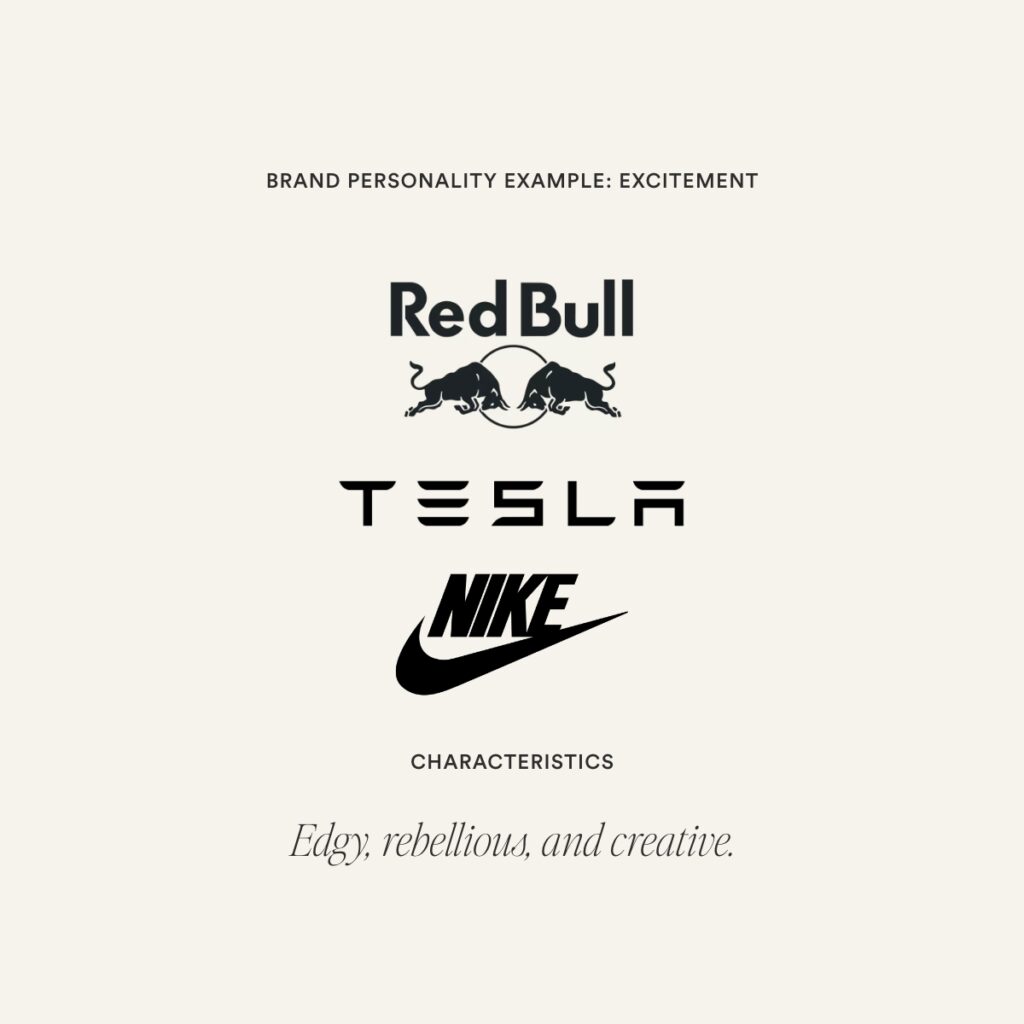
- Competence
Characteristics: Intelligent, reliable, respected.
Examples of competent brands: Microsoft, Google, and Volvo.
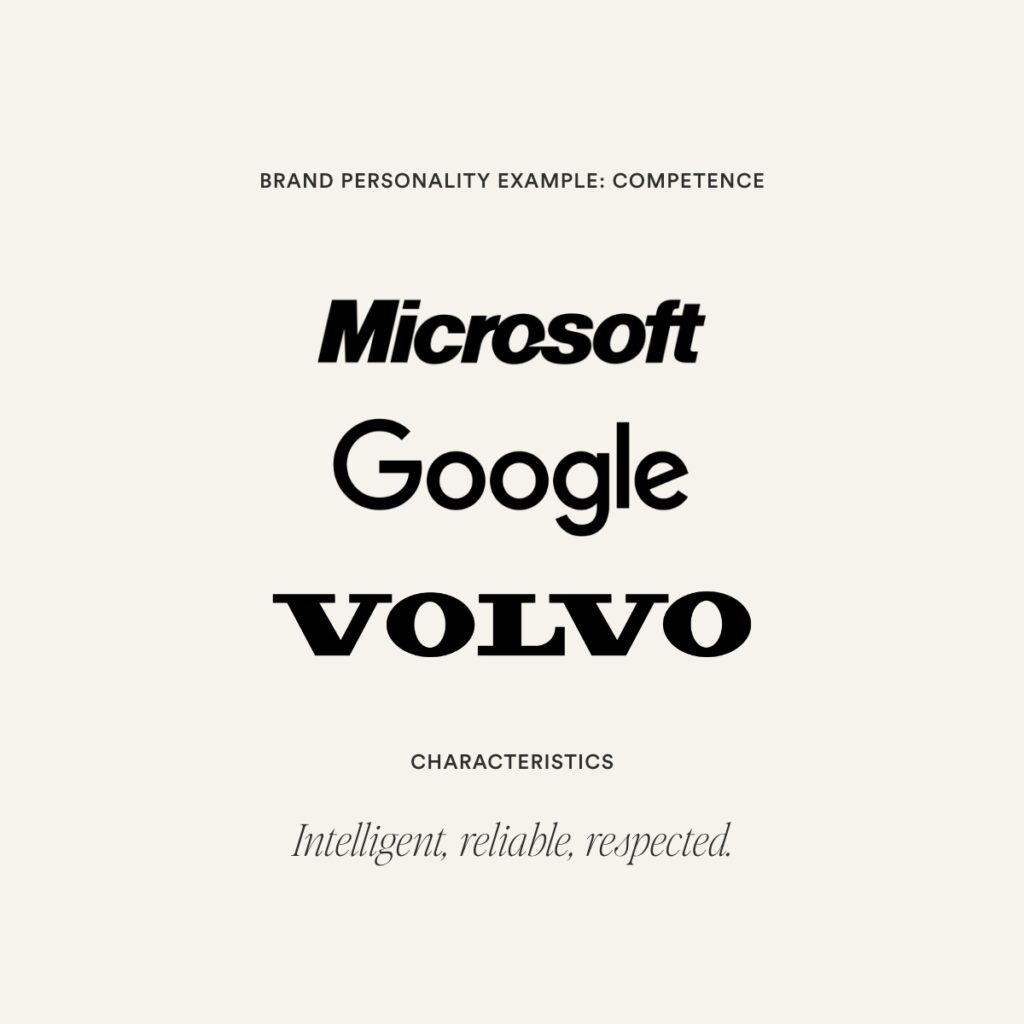
- Sophistication
Characteristics: Glamorous, luxurious, and seductive.
Examples of sophisticated brands: Tiffany & Co., Gucci, and Alfa Romeo.
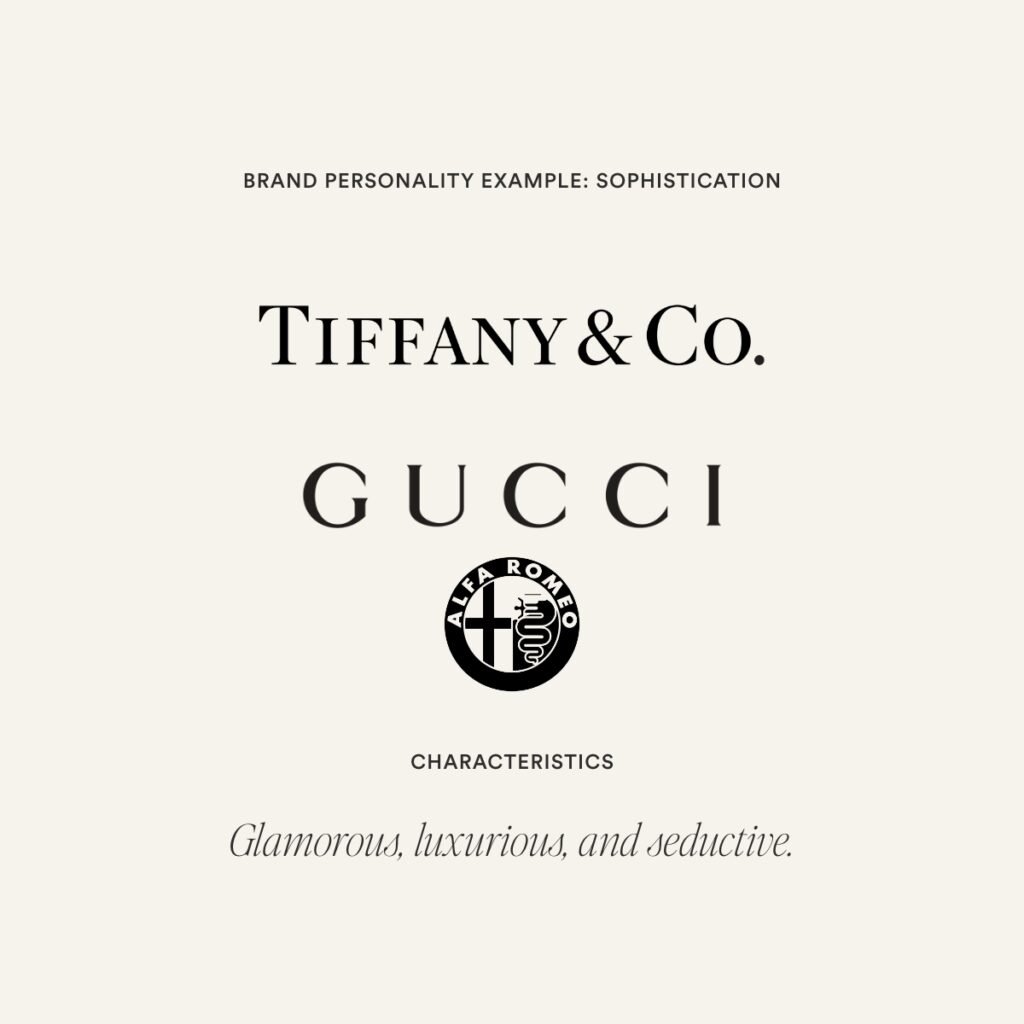
Brand Personality Builder: Step 3 – Discover Your Brand Archetype(s)
When teaching people how to create a brand, this is one of my favourite techniques.
Brand archetypes allow you to pin-point and inject your brand with human personality.
While Aaker’s Dimensions of Brand Personality is a fantastic springboard, I hugely encourage you to take it one step further and enter the world of brand archetypes.
Coined by psychologist Carl Jung in 1940’s, archetypes were applied to the world of branding in 2001 by Mark and Pearson to help people with how to create a brand. A relatively new concept in the world of branding, it made complete sense to leverage a psychological theory made for humans and apply it to brands. Why? Because we buy from people, not robots.
Brand archetypes are made of 12 key roles. It’s said that every brand will have one dominant archetype and perhaps 2-3 sub-archetypes.
Take a look at my article about brand archetypes in depth for more information about each of the archetypes and how to use them. However, for a rough overview, here are the names of each of the archetypes:
- The Creator
- The Sage
- The Caregiver
- The Innocent
- The Jester
- The Magician
- The Ruler
- The Hero
- The Everyman
- The Rebel
- The Explorer
- The Lover
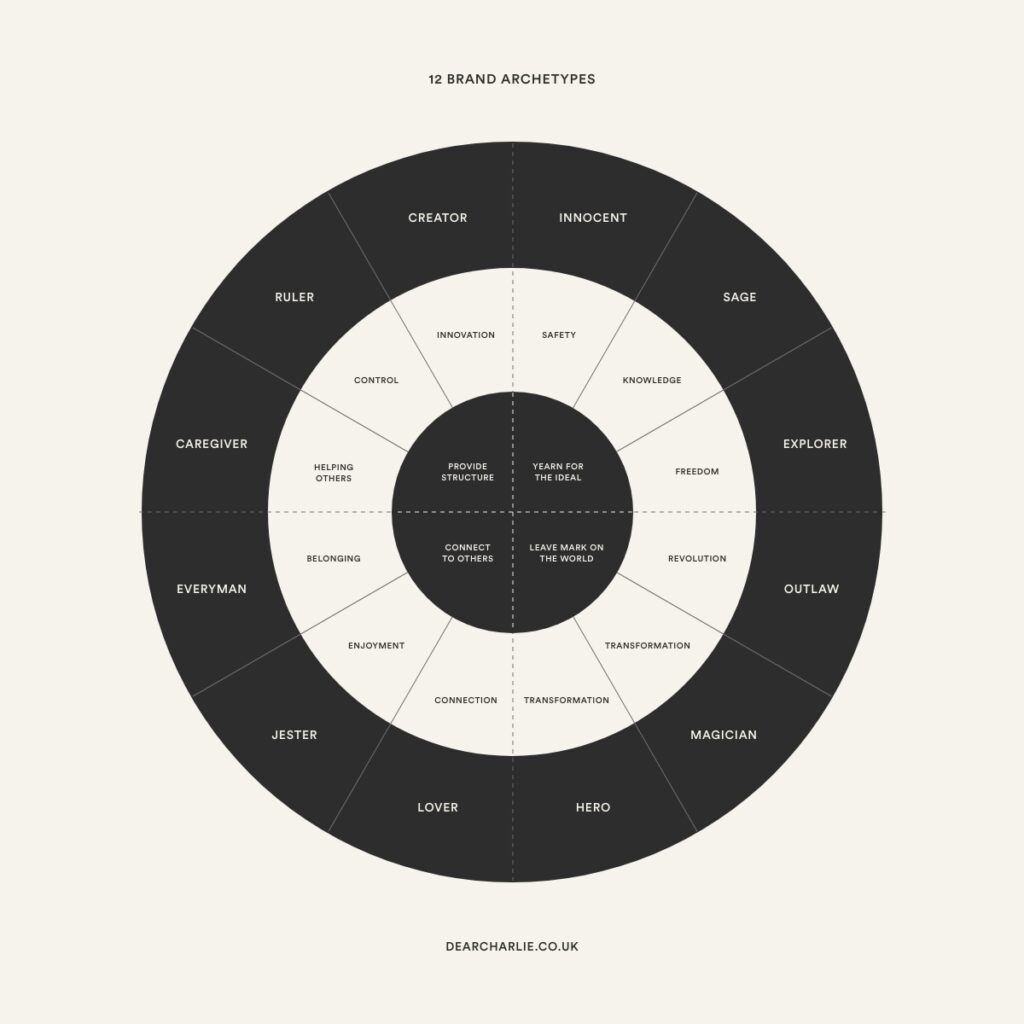
Brand Personality Builder: Step 4 – Pinpoint Your Brand’s Personality Traits
When creating a character for a script or novel, the first terms that get thrown around are personality traits. Labels like “funny,” “mysterious,” and “empathetic” help define the character and inform their actions.
We justify the actions of villains, for example, because “they’re very volatile.”
As you learn how to create a brand, you’ll recognise how important it is to understand and define your brand’s personality traits, too.
Begin by mind-mapping as many personality traits as you can with your brand’s name in the middle.
Then, use a highlighter to underline the most prevalent 4-5 traits. These are your core brand personality traits.
And while the others make up your brand’s personality, too, the 4-5 you’ve highlighted needs to be your prime focus.
You’ll learn, as you understand how to create a brand, that every brand is different. Even if you had two brands that fell under the same archetype, they’d have unique personalities.
Take, for example, The Lover archetype. This archetype is leveraged by brands like Victoria Secret and Haagen-Dazs. Despite the two sharing the same dominant archetype, they have very different personalities. They take very different routes in how to create a brand.
So, it’s crucial to pinpoint the traits you want to put out in the world.
5. Create A Logo That Encompasses Everything You’ve Worked On And Stands Out
Now the groundwork has been laid in terms of how to create a brand, it’s time to get creative.
At this point, you’ve learned that, to develop a memorable and unique brand in 2023, you have to know your audience, do your research, understand your brand, and pinpoint your brand personality.
It’s now time to put all this information and discovery to use and use a logo that encompasses everything you’ve learned so far as a prime outlet in terms of how to create a brand.
We know, too, that your brand is far more than just your logo. However, when starting with how to create a brand, it’s a great place to springboard when developing a solid brand identity.
Your logo needs to be an extension of your brand’s personality. It needs to convey a message to the ideal client or buyer. And it needs to evoke some sort of feeling.
What We Can Learn From The Pros In How To Create a Brand
Fabrik Brands published an article about the top 10 most recognised brand logos in the world. Making the cut included brands like Starbucks, Amazon, Google, Pepsi, and McDonald’s. All wildly different, but incredibly successful.
Why? Because their designers knew how to create a brand. They understood that it wasn’t enough to create a logo that simply looked good. It needed to encompass the brand’s value, position, personality, morals, and speak to the ideal consumer.
What Makes a Logo Good?
The 5 principles of effective logo design says that, for a logo to be good, it needs to be:
- Simple
Simplicity does not mean “easy.” It means identifiable. And, at times, that can be far trickier to achieve than something complex and crowded. - Memorable
If someone sees your logo on the train home from a long day at work, would they remember it? Despite it being simple, there needs to be something about it that is different from every other logo out there. - Timeless
Your logo is a component of your brand identity that likely won’t change. If you feel the need to change your logo every five minutes, it isn’t representing your brand in the right way. As such, your logo needs to be evergreen and timeless rather than following the latest marketing trends. - Versatile
Your logo will make an appearance across a variety of different channels and touch-points. With that in mind, it’s important that your logo is versatile, and adapts to different contexts well. - Appropriate
Finally, your logo needs to be appropriate for your ideal client, sit well within your industry, and not stir any resentment, confusion, or the notion that it isn’t appropriate.
Assign A Colour Palette Using Colour Psychology
The next step in how to create a brand in 2023 is through the use of colour.
There are many startups out there who will assign a colour palette based on personal taste. This becomes problematic on many levels.
Instead, you should determine your brand’s colour palette based on colour psychology. Your personal taste has, in fact, nothing to do with it.
What Is Colour Psychology?
Colour psychology is a prime strategy in how to create a brand. In a nutshell, certain colours evoke specific feelings. Have you, for example, ever encountered a hospital that uses pink as their dominant colour in their marketing and branding?
It’s unlikely that you have. Because big brands – the ones who know how to create a brand – leverage colour psychology to take control of the public’s perception of them.
Colour psychology is a topic all by itself. But if we’re going to summarise it, then use the table below for guidance. Realistically, it depends largely on who your brand is and who you serve, but this is a good starting point.
Colours evoke certain feelings, but also allow your potential customers to understand your core values.
| Use this colour | to demonstrate your brand is |
| Green | Kind, mature, responsible, balanced, fresh, and organic. |
| Blue | Serene, tranquil, patient, wise, spiritual, elegant, and dependable. |
| Red | Passionate, sensual, dramatic, urgent, confident, lively, hungry. |
| Purple | Luxurious, regal, fantastical, spiritual, magical, creative, and wealthy. |
| Pink | Romantic, feminine, soothing, playful, modern, sweet, and positive. |
| Orange | Warm, encouraging, optimistic, curious, fun, engaging, and youthful. |
| Yellow | Energetic, warm, fun, enthusiastic, fresh, bright, and happy. |
| Brown | Earthy, reliable, natural, approachable, aesthetically-driven, practical, and stable. |
| Grey | Modern, timeless, reliable, elegant, graceful, minimal, and conservative. |
| Black | Bold, dramatic, timeless, glamorous, mysterious, deep, elegant, and authoritative. |
Colour Psychology Rule: Consider The Negatives Too
Colour can boost your brand recognition levels by up to 80%. That’s one huge leap just by selecting the right colour palette, which is why colour psychology is one of the most crucial parts in how to create a brand.
That’s why it’s so crucial not to pick a few colours out of thin air.
But, it’s absolutely fundamental to understand the rules of colour psychology.
In the table above, I showed you the positives of each of the colours in terms of colour psychology.
However, you need to understand and acknowledge the negatives of each colour, too.
By understanding colours and seeing brands use them in real life, you’ll be able to assign a colour palette based on strategy and genuine understanding. That beats just saying “I’ll have blue because it’s my fave colour!” Further proof that colour psychology is a leading strategy in how to create a brand.
| Positives | Negatives | Brands That Use It | |
| Green | Luck, freshness, prosperity, and growth. | Envy, sickness, boredom, and enervation. | Land Rover, Starbucks, Spotify, and BP. |
| Blue | Trust, tranquility, reliability, and loyalty. | Coldness, emotionless, robotic, and sadness. | IBM, PayPal, Samsung, and Dropbox. |
| Red | Passion, sensuality, strength, and excitement. | Anger, aggression, pain, violence, and defiance. | Nintendo, CNN, Netflix, and H&M. |
| Pink | Femininity, playfulness, sweetness, and creativity. | Impulsiveness, flippancy, naive, and immaturity. | Barbie, Lyft, Cosmopolitan, and LG. |
| Orange | Warmth, courage, approachability, and creativity. | Frustration, immaturity, deprivation, and ignorance. | Etsy, Penguin, SoundCloud, and Nickelodeon. |
| Yellow | Extraversion, energy, happiness, and creativity. | Anxiety, frustration, fear, and warning. | Bic, National Geographic, Post-It, and Ferrari. |
| Brown | Earthiness, warmth, reliability, and strength. | Seriousness, pessimism, dirtiness, and heaviness. | UPS, Hershey, M&Ms, and Dreyers. |
| Grey | Intelligence, strength, balance, and timelessness. | Lack of energy, blandness, indecisiveness, boredom. | Apple, Jaguar, WordPress, and Wikipedia. |
| Black | Power, sophistication, elegance, and authority. | Mourning, loss, heaviness, and coldness. | WWF, BBC, Sony, and Adidas. |
Colour Psychology Rule: Prioritise Authenticity
Note that I am telling you to prioritise authenticity when choosing your colour palette rather than originality.
Don’t select a shade of purple just because you haven’t seen it done before. Originality is important, but authenticity? It trumps it all when it comes to how to create a brand.
Your colour palette needs to reflect all of the work you’ve done in the previous steps. If, for example, you identified that your brand was an Explorer archetype with the main personality traits of “adventurous,” “rebellious,” and “adaptable,” then choosing pink may not work for you.
Moving onto the intricacies of how to create a brand, you have to think carefully about the colours that best represent your brand’s personality. Because, if you’ve followed the steps, your brand’s personality will be tailored to appeal to your ideal consumer. That’s why the foundations are so crucial to build first.
7. Select Typography With Your Brand’s Personality in Mind
Typography is a fancy word for font selection. And playing with fonts was likely one of the first things you did on a computer. Remember Word Art on Microsoft word?
Since those early days, you’ve come a long way. You’re now learning how to create a brand. And in 2023, choosing your fonts isn’t as easy as playing around on Microsoft Word.
Of course, some people do just that. But they end up with a disjointed brand that isn’t memorable, unique, or perceived in the right way.
Ranked as just as important as your brand’s colour palette, your brand’s typography (AKA; fonts) are a staple that make your brand who she is.
The Different Types of Fonts
To choose the right typography for your brand, you need to identify the different types of fonts out there. Each type of font carries personality traits, much like how each colour conveys different traits, quirks, and beliefs.
Here’s a quick check-list that outlines the different types of fonts and what they stand for:
- Serif fonts Traits:
Formal, traditional, respectable.
Examples: Times New Roman, Playfair Display, and Frank Ruhl Libre.
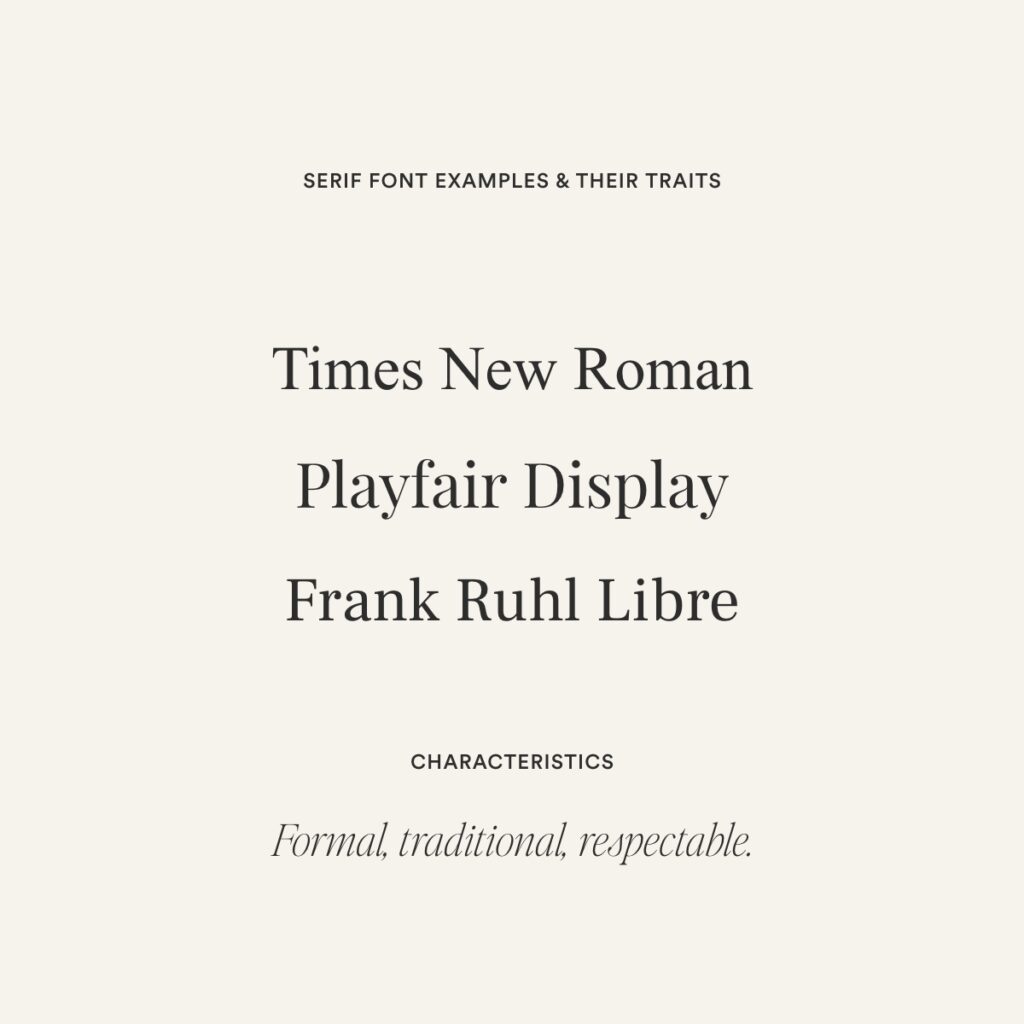
- Sans Serif fonts Traits:
Modern, simplistic, clear.
Examples: Montserrat, Arial, and Open Sans.
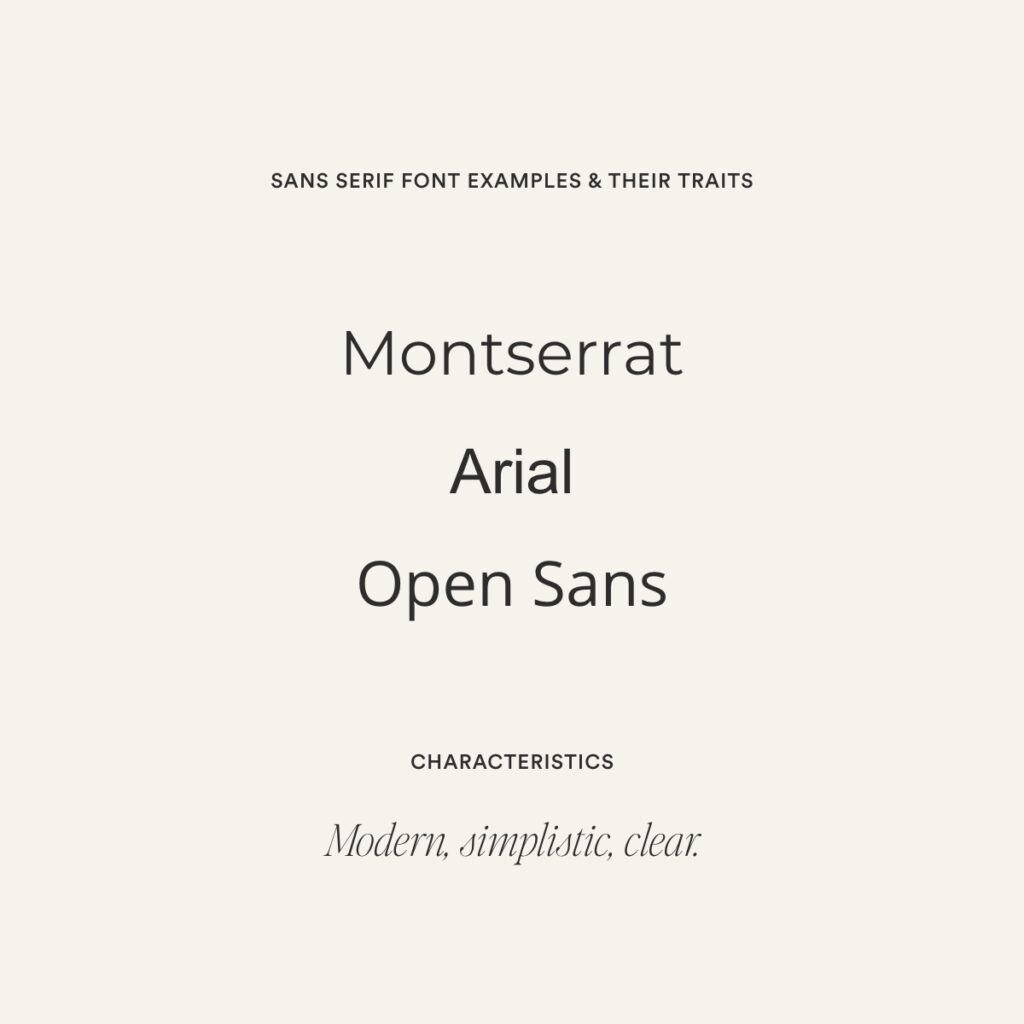
- Slab Serif fonts Traits:
Bold, dramatic, creative.
Examples: Sanchez Slab, Calistoga, and Abril Fatface.

- Script fonts Traits:
Feminine, free-spirited, elegant.
Examples: Sloop, Marithonia, Delighted Sunrise.
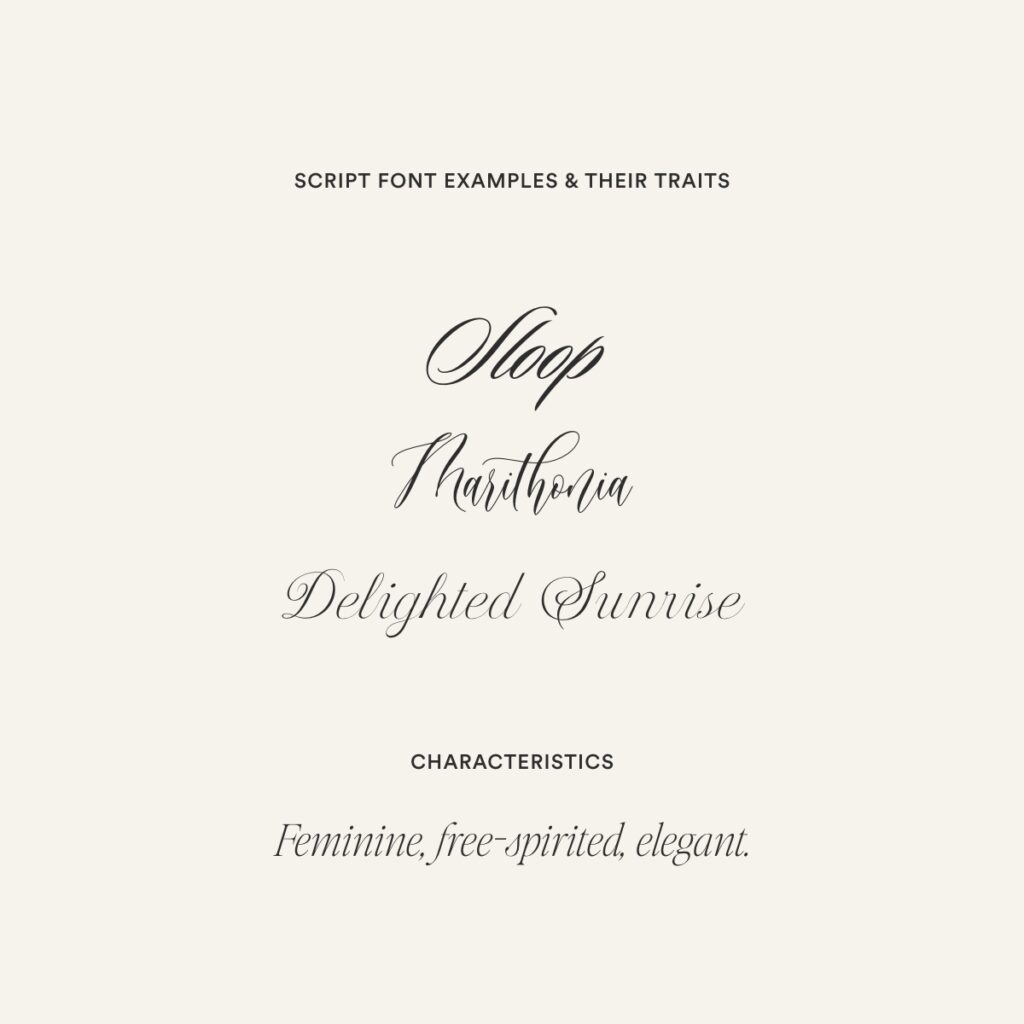
- Decorative/ Display fonts Traits:
Unique, unconventional, fun.
Examples: Random, Moonie Eyes, and Burra.
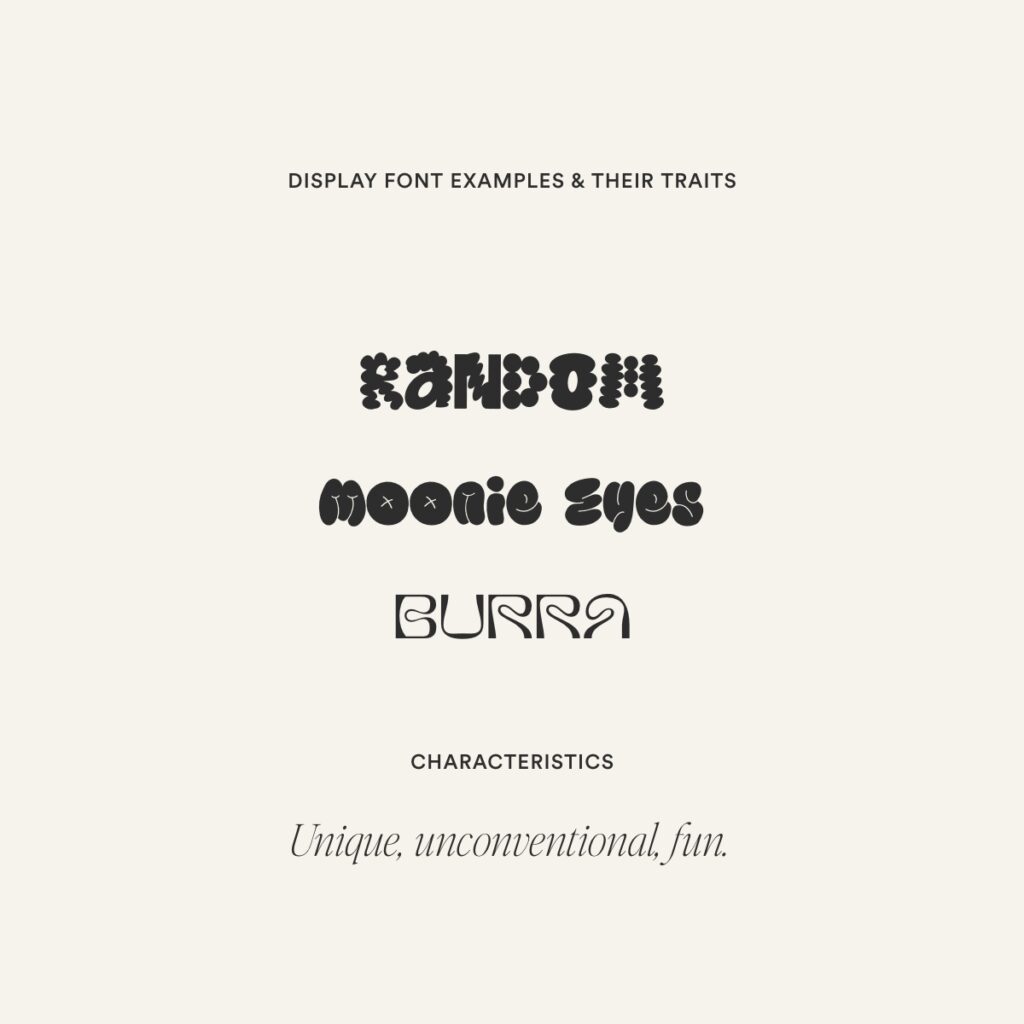
- Handwritten fonts Traits:
Informal, playful, artistic.
Examples: Beach Bound Script, Homemade Apple, and Grandstander.
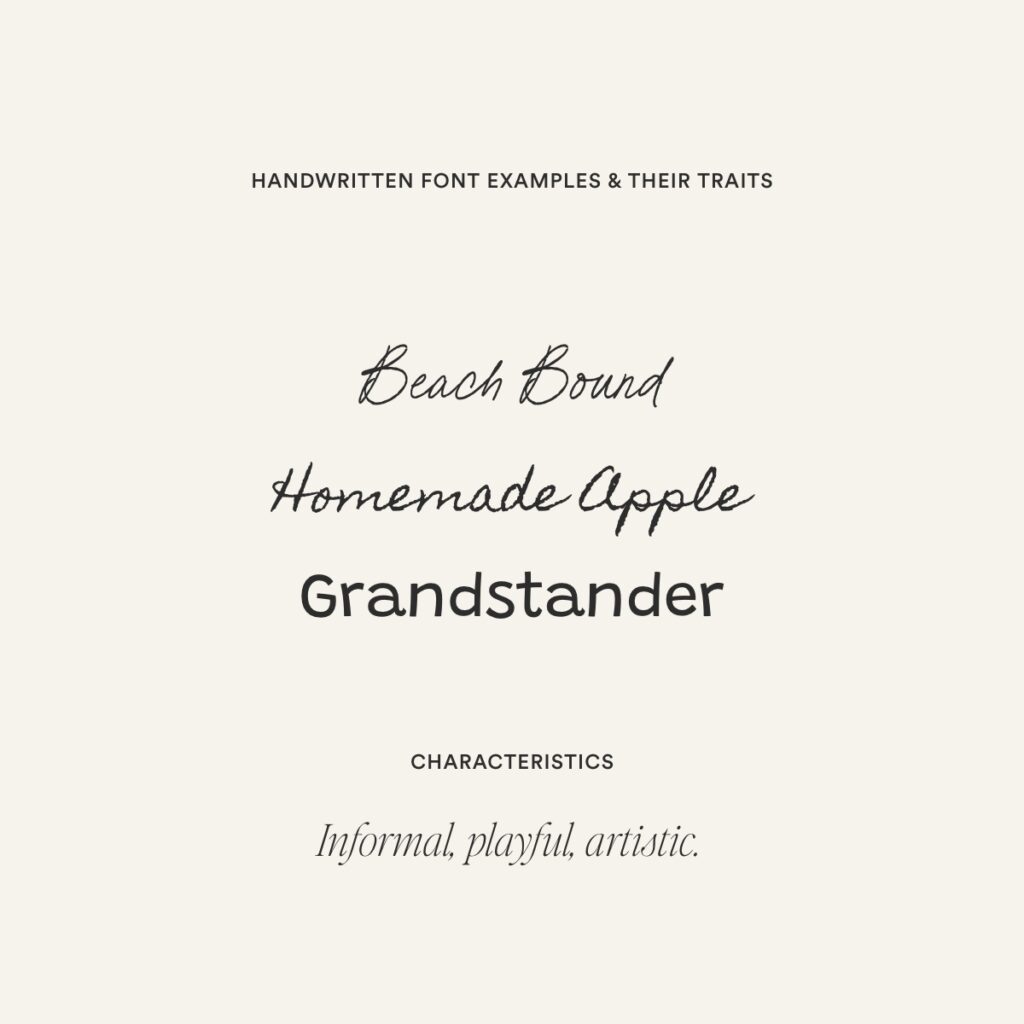
Key Note: It’s fundamental that your fonts are legible. There’s little point in choosing a font that looks great if no one can actually read it.
8. Define Graphic Success Criteria For Your Brand
Creating your logo and choosing your colours and fonts are only one part of the jigsaw puzzle. Realistically, it’s a huge part of how to create a brand. But one part nonetheless.
Branding extends to everything you do as a brand. Whether that’s posting on social media, creating white papers, business cards, or even slideshows.
You’ll need visual assets when mapping out your brand identity. Visual assets are anything visual that contribute to your brand. Things like photos, infographics, illustrations, GIFs, and even video thumbnails.
Many business owners will select photographs at random. Say, for example, you were running a blog. You’d need to select photos with care, thinking about whether the photo aligns with your brand guidelines.
The key in how to create a brand – as I’m sure you’ve heard – is consistency. Here are some of the other visual assets that you will need to consider carefully:
Imagery and Photography
The images and photos you choose need to be on brand. If, for example, your business is all about healthy eating, it would make no sense to use a photo of a cupcake covered in buttercream.
Choose the right style of photos and images by following this checklist:
- Does this image align with the personality traits of my brand?
- Is this image in high resolution?
- Does this image go against any of my brand’s core values and beliefs?
- If there was no wording here, what would this image convey to my viewer? Is this something I approve of?
- Do the colours in this image work with my colour palette?
Icons
In the age of social media marketing, it’s likely that you’ll need icons for – at the very least – your social channels. The “save,” “like,” and “comment” icons are universally understood.
So, the way your icons are designed need to be in line with your visual brand. Customising your icons is a sure way to strengthen the solidity of your branding, allowing them to be a dominant player in how to create a brand.
Your brand’s icons can be used in the following places:
- Your logo
- Your social media channels
- Your website
- Your white papers
- Your business card(s)
- Your packaging
- Your opt-in forms and newsletters
- Your presentations and slide-decks
And so much more.
Use the icon-success criteria below to ensure you’re using branded icons effectively.
Icon Success Criteria in Branding
Icons are incredibly effective in the world of branding. However, it’s important that they are all on brand and clear.
Use the following questions to make sure your icons are working the way they should:
- Is the icon synonymous with the message?
If the words weren’t there, would the viewer be able to understand the message? - Does the icon summarise the transformation in visual form?
Based on the action you’re hoping to achieve, does the icon represent what’s in it for them? - If using text in the icon, are you using less than 2 words?
Using text isn’t necessarily a “bad” thing. But you should try to stick to one or two words for legibility. - Do the icons use colours from your colour palette?
Consistency is key, after all. Your colours in your icons need to reinforce your colour palette. - Do your icons follow the same design standards?
If, for example, you were creating a search bar icon, you’d need to choose whether you wanted the icon completely filled in or outlined. Do they use a shadow? Are they realistic or more animated? Every one of your icons need to sing from the same hymn sheet.
Mascots
Please hear me when I say: not every brand needs a mascot. A mascot is not “how to create a brand 101.”
It comes down to whether your audience would best relate to a mascot, what that mascot does to reinforce your brand’s value, ethos, and beliefs, and whether you believe it’s a strong marketing move.
For some brands, mascots work. Consider Fairy. When you think about Fairy Liquid, one of the first things you think about is the baby.
However, there are many brands out there that don’t need a mascot, and – in fact – brands that, if they had a mascot, it’d be detrimental.
That said, if you believe a mascot is the right direction for you, you’ll need to choose and create with care.
Submarks
Finally, you’ll need to consider your brand’s submarks.
A brand’s submark is their secondary logo. When the main logo doesn’t work in certain contexts, the submark can be leveraged and applied there, instead.
For example, your logo might not work well on a business card. So, instead, the submark will be used.
It’s critical that your submark aligns with your primary logo. There needs to be fluency between them, making them siblings rather than twins or cousins.
What Makes A Good Submark?
A good submark is a key player in how to create a brand, and should tick the following boxes:
- Has the same feeling as your primary logo
- Carries cohesion with your branding
- Uses your brand’s fonts
- Uses your brand’s colour palette
- Uses the same textures and styles
- Is legible and clear
- Relays the brand’s value instantly
A submark is – while secondary to your primary logo – one of the most used visual assets in branding. Consider it as a watermark, reinforcing your brand’s presence as frequently as possible.
How to Create a Brand In 2023
See. I told you branding was far more than logos.
From laying solid foundations with your brand’s positioning and purpose to carefully selecting the right colours and typography, assessing the overall stylistic direction of your brand, and everything in between, learning how to create a brand isn’t a piece of cake.
That said, the reward is staggering. A solid brand improves retention, trust levels, sales, and overall brand success. So, while you need to put the work in, it’s so worth it.
Whether you choose to DIY your branding or you’re ready to work with a brand strategist to design and develop a super-strong, memorable brand, the first step is to accept that it’s an intense (but fundamental) journey.
That said, if you’re doing it right (or doing it with someone who knows their brand identity from their brand strategy,) it’s a wonderful experience full of creativity and fun.
So, this 2023, make it your mission to build a memorable and unique brand that speaks to the right people, oozes your brand’s beliefs and purpose, and stands proud in your industry.
Come 1st January 2024, you’ll thank me, 100%.




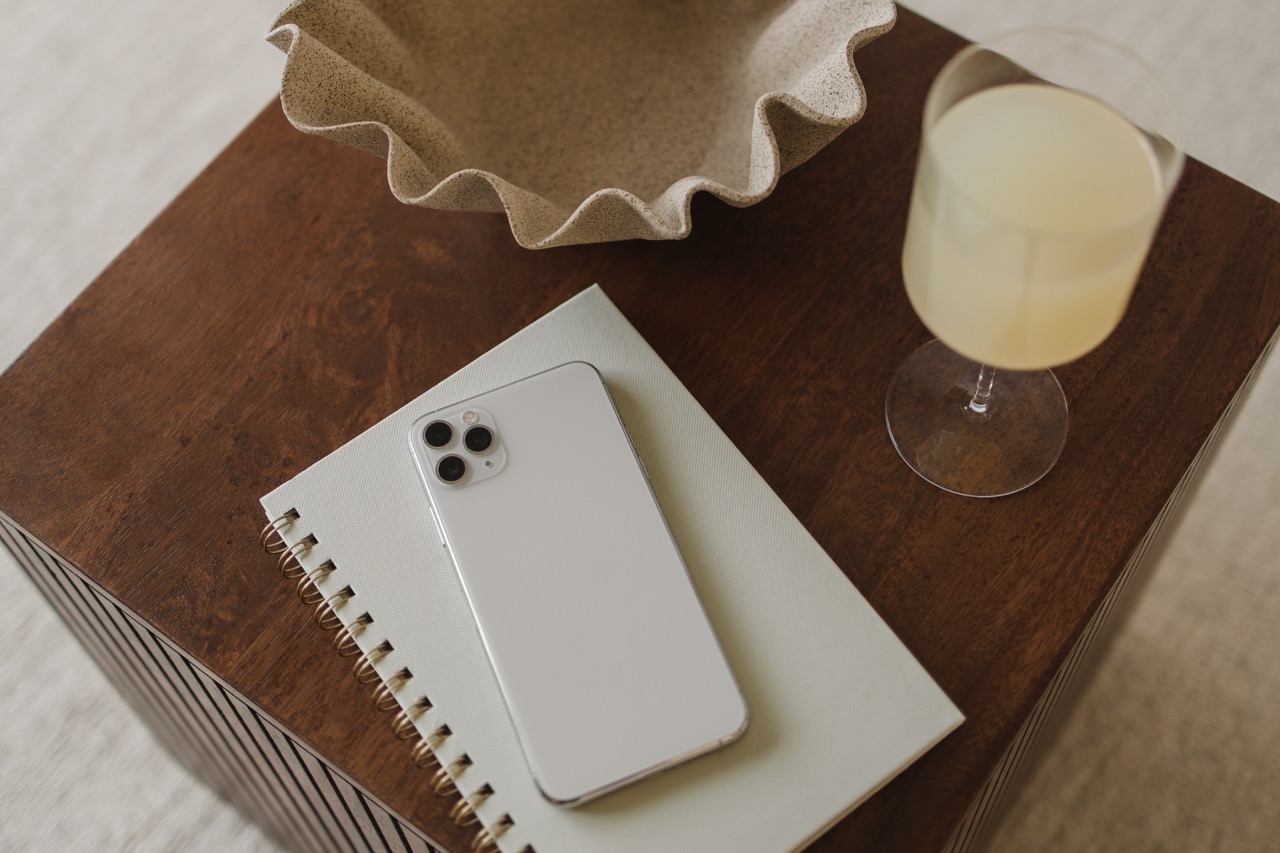
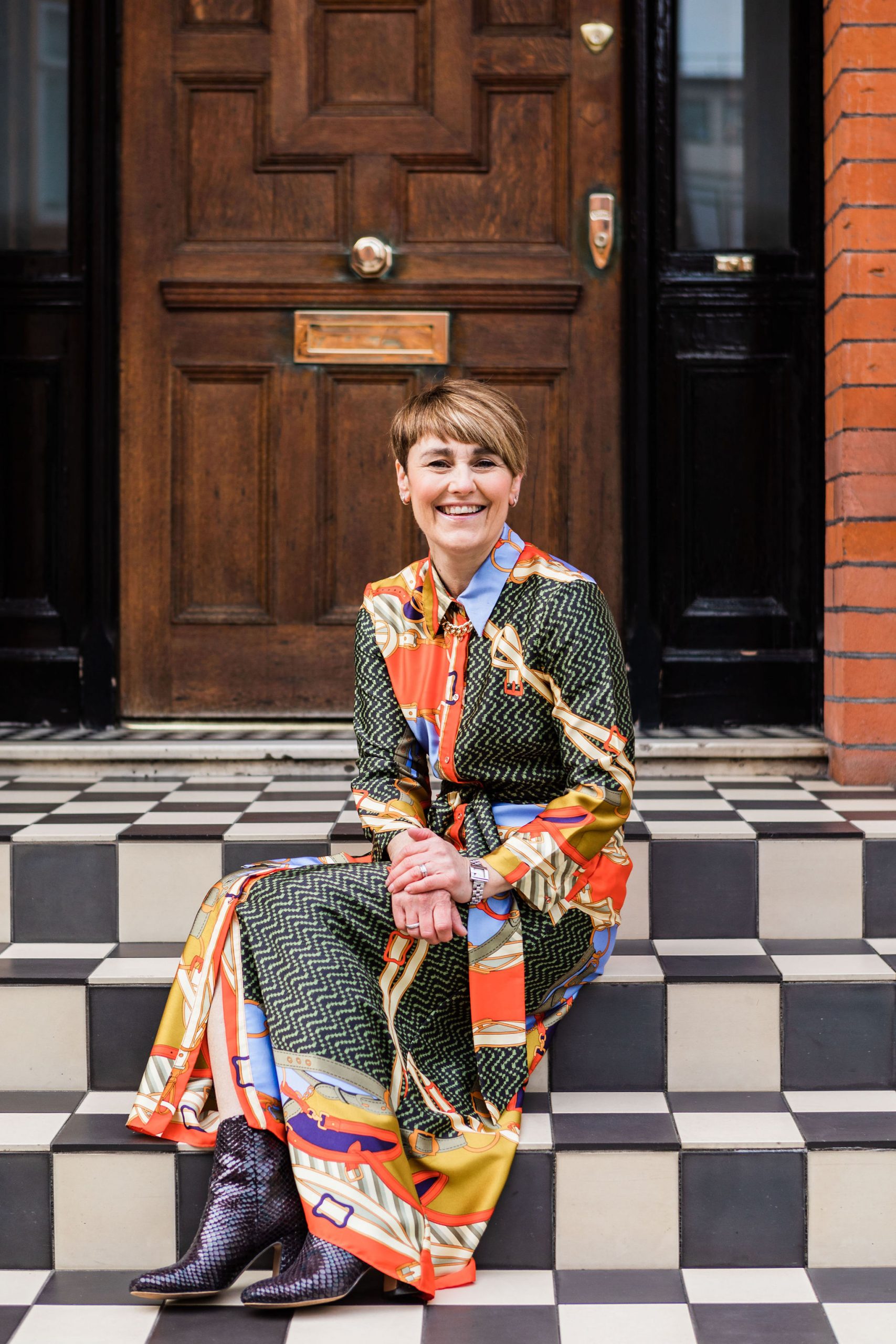
Leave a Reply